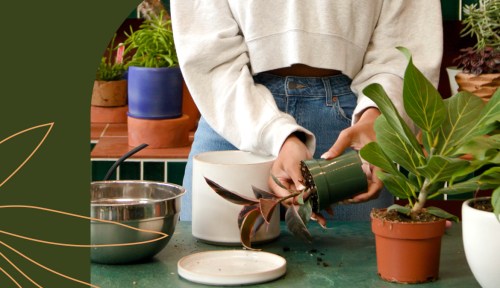Our editors independently select these products. Making a purchase through our links may earn Well+Good a commission
How To Repot a Plant in 4 Easy Steps Without Killing It
If you're scared of moving your plants, you're not alone. Learn here exactly how to repot a plant without killing it, according to experts.

The idea of repotting your favorite plants might make you anxious. While you know your green friend would be happier in a bigger home, you’re afraid moving it will kill it. But learning how to repot a plant is easier than you think, and helping it make the move is often better than keeping it as-is and hoping for the best. Plant doctor and stylist Maryah Greene says there are two main reasons you want to repot your plants.
Experts in This Article
plant expert and founder of Greene Piece
professional organic farmer, certified permaculture teacher, and co-founder of Green Valley Gardens
professional gardener and floral designer of Bloomful Floral Design
“One, we want brand new fresh soil that’s filled with nutrients,” says Greene in an episode of of Greene Thumb by Well+Good, a series on the Well+Good YouTube channel. “The second reason—plants run out of space, and so you want to report them in something an inch or two bigger, so they can grow nice and tall.”
When to repot a plant
Just prior to the new growing season, late winter or early spring is the best time of the year to repot a plant, according to Susan Spanger, professional gardener and floral designer of Bloomful Floral Design. There’s a good chance yours needs it, too: “The general rule is that young and fast-growing plants will need to be repotted every six months to a year, and older plants need to be repotted every few years,” she says.
There are more reasons to repot a plant aside from its age, though—Greene says your plant will tell you it needs a bigger home when its leaves begin to drop off.
“The first sign is seeing equal rates of new growth and a couple of leaves falling off at the same time,” says Greene. This happens because the new roots are being squished by the old roots, she says. Roots desperately need additional space to stay healthy and grow.
“If a plant’s root system is confined to a container for too long, it can become root bound. Simply put, most root bound plants are those that have grown too large for their container or pot,” says Spanger. “You’ll know if this has happened if the roots have taken up too much space within the pot, forming a circular dense web of roots. Or, if the roots are protruding from the drainage holes or are too exposed with inadequate soil covering them.”
Additionally, the soil may start to change colors. “You might see the little white rocks called perlite, turning yellow or brown, and that’s a sign that it’s time for fresh oil,” says Greene.
“But, if you’ve got a really massive plant, you may not need to repot it,” says Greene. “I often get the question a lot, ‘Do I need to keep reporting my really massive plant?’ Not necessarily. You may just need to replace the soil content, so one of the things you can try is adding topsoil.”
To make sure your plant thrives for years to come, follow these easy-to-follow instructions on how to repot a plant without killing it.
How to repot a plant without killing it
While the only repotting supplies you’ll need are a pot, proper soil, pruning shears, and gardening gloves, plant essentials like neem oil, an insecticide, and fertilizer should be included in your new plant checklist in order to prevent pests and ensure your plant’s longevity.
Supplies you’ll need:
- A plant
- A new pot
- A gardening spade (optional)
- Nutrient-rich soil
- Scissors or pruning shears
- Gardening gloves
1. Choose the right pot
When you’re repotting your plant, you don’t necessarily need to move it to a bigger one. Sometimes your plant’s potting mix just needs to be refreshed to provide it with new nutrients. But if your plant is getting too big for its pot, choose a new one that’s only a little bigger.
“You want to make sure you find the right size pot for your original plant,” says Greene. “Ideally you’re finding something with one to two inches in diameter of extra room.” If you choose a pot that’s too big, you run the risk of overwatering and root rot (the most common killer!), which is more likely when a plant is swimming in potting mix.
Proper plant drainage is also key for keeping your plant healthy. The best pots for indoor plants have either one or a series of holes that allow excess water to drain out of the plant and soil. Without proper water drainage, water can accumulate at the bottom of your plant, leading to fungus and root decay. These conditions attract fungus gnats, pesty flying insects that reproduce rapidly. While not all plantsneed drainage holes to thrive, picking out a pot that has them can save you from a world of worry in the future.
As for the material, natural materials like terra cotta are exceptional for indoor plant pots. Terra cotta pots are porous and provide better drainage and airflow for plants, which prevents fungal and bacterial growth. Concrete and ceramic are also porous, making them smart material choices for your pot.
In a pinch, other materials like plastic work, too. If you’re a thrifty plant parent who doesn’t want to buy a new pot, you could even upcycle a plastic container to make a decent pot for your indoor plants.
If you don’t mind the cost, self-watering pots take the guesswork out of daily watering and can help prevent overwatering, a common mistake amongst novice gardeners.
2. Buy the right soil
If you’re unsure which type of potting soil to buy, Spanger recommends a blend that’s 70 percent coarse-fibered peat moss combined with a 30 percent perlite. “You’ll recognize perlite as the tiny, roundish white specks which introduce air into the soil amid the other components,” she says.
Consider where your plant will live once it’s been repotted. If you’re keeping the plant inside your home, opt for indoor plant soil, which is often formulated to promote proper drainage and deter fungal growth.
When repotting the plant, start by filling the pot a third of the way up with fresh soil to the pot. “That way it has room for all the new roots to grow,” says Greene. “How much soil you add is often a guessing game, but you can always add more.”
For an added nutrient boost, permaculturist and Green Valley Gardens owner Matthew Williams recommends adding worm castings into your soil mixture with a ratio of one part worm castings to two parts soil. Worm castings, aka worm manure, contain essential nutrients like iron and nitrogen and support proper aeration and drainage for your plant.
3. Inspect, loosen up, and prune the roots
Now that you have everything you need to repot your plant, you’re ready to get started! Put on your gardening gloves and gather your potted plant, the new pot, the soil, and the shears. Gently separate the soil inside your potted plant from the pot’s edges, carefully digging the roots and soil mixture as you go. While optional, a gardening spade can help you with the depotting process.
“Once it comes out of the [old] pot, you can inspect the roots and you can see that it’s perfectly in this cylinder shape, and ideally we want to untangle the roots so that it can grow out,” says Greene. “Roots can be kind of delicate, so you don’t want to pull too much. You can use your fingers to get rid of as much soil as you possibly can without disrupting the system. The reason we’re getting rid of soil is because we’re replacing it with new soil.”
If your plant is super root bound with a really tight root ball, Spanger says you might need to use a clean knife. Simply make a few cuts on the bottoms and sides of the plant that allow you to loosen the roots up.
After loosening them up, you may find that your plant’s roots have grown especially long while inside their previous pot. If so, use your pair of scissors or gardening shears to carefully trim the longer, stringier roots that have grown in excess. This important step is called root pruning, and according to Williams, it’s crucial for boosting your plant’s longevity and controlling how large the plant will grow. Root pruning also helps prevent root binding from happening after your plant has been rehomed. When plants are root bound, they have a difficult time properly absorbing water and nutrients, often resulting in the plant leaves turning yellow.
“Pruning roots stimulates new growth,” adds Williams, “so it’s always a good idea to do that step.”
4. Put your plant in its new home and water it lightly
After you loosen up your plant’s roots, it’s time to repot it.
“After filling the pot to the base with fresh potting soil, place the root ball on top in the center. You need to make sure the surface of the root ball is below the rim so it’s covered sufficiently with soil,” says Spanger. “Once it’s correctly positioned in the pot, gently place soil around and over the roots, giving them the ability to move and grow.”
When adding soil, you want to pat the soil down. “You want to do the finger test because if you put your finger on top of the soil and it falls through, the soil isn’t tightly packed enough,” says Greene. “Use two fingers to pat it down. Roots really enjoy tight, compact soil for them to grow into.” Leave about half an inch to a quarter-inch of space at the top so water doesn’t overflow over the pot while watering. “And this is the best time to center your plant,” she says. Finish by lightly watering your plant, then don’t water it again for at least a week to give it time to adjust.
Before putting your potted plant back in its original spot, consider the species’ environmental needs. Low light plants might thrive in a dimly-lit office, but others, like aloe vera, need direct sunlight in order to thrive. Exposing a newly-potted plant to harsh, direct sunlight or strong winds could send the plant into shock; if placing outside, put it in a covered area with indirect sunlight.
Once you’ve repotted your plant and found it a proper spot to stay in, water it lightly. This helps keep your plant hydrated as it recovers from the stress of repotting, and helps the roots take hold of the new soil by reducing any trapped air in the pot. From here on out, try to water your newly-potted plant in the morning; this is the best time to water plants, since the soil will have a chance to fully dry out through the course of the day before its next watering.
Commonly asked questions
Should you water plants when you repot them?
You should water your plant a few days before you plan to repot them.
This not only ensures your plant is properly hydrated before going through the stress of root pruning and rehoming, it also helps loosen up the soil, which will make it easier for you to remove your plant from its old home.
Does repotting hurt plants?
Repotting can be an incredibly stressful event for plants, so much so that they can sometimes experience what’s called ‘transplant shock’ after being repotted. This shock occurs when a plant’s environment changes drastically throughout the depotting and repotting process.
Making sure your plant is properly hydrated days before the repotting process can help prevent this. Don’t oversaturate it, warns Williams. “Too little water is not good, and too much water is not good,” he says.
Placing your plant in indirect sunlight after repotting, keeping it covered from harsh environmental factors like heavy winds and rain, and using nutrient-rich soil can also prevent transplant shock.
How do you repot a plant without killing it?
Keeping a plant alive can be tricky for anyone–even those who have a green thumb.
If you want to repot your plant without killing it, be gentle with its leaves, stems, and roots during the removal and planting process. Using nutrient-rich soil that’s appropriate for your plant type, watering it a few days before depotting, and placing the newly-potted plant in indirect sunlight will help your plant bounce back quickly.
Why should you break up roots when repotting?
When roots don’t have enough space to spread out, they can become what is called ‘root bound’. A root bound plant’s roots are so tightly packed together that they begin to suffocate, unable to draw in nutrients from soil and water. This is also why breaking up and pruning your plant’s roots is such an important step of repotting a plant.
“Pruning roots promotes growth,” says Williams. “You would think it would hurt the plant’s growth, but pruning the roots actually promotes new growth!”
Sign Up for Our Daily Newsletter
Get all the latest in wellness, trends, food, fitness, beauty, and more delivered right to your inbox.
Got it, you've been added to our email list.








